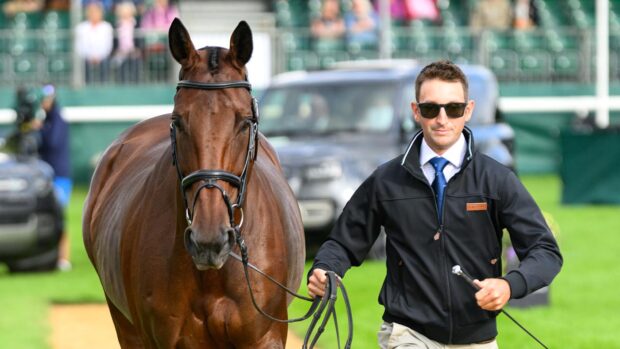New research conducted during international competitions has proven the link between fatigue and a horse’s stride and jump on cross-country courses.
The study, published in the Equine Veterinary Journal, was carried out at the Institut Équestre National Avenches (IENA) in Switzerland, in 2020 and 2021, at training, a CCI4*-S, and the European Eventing Championships. It is one of several recent peer-reviewed studies using company Alogo’s measuring technology.
The aim of the research was to analyse changes to strides both on the flat and at jumps on a cross-country course, and to identify characteristics potentially associated with a tiring horse. It is hoped that the findings will be useful evidence for course-designers and riders.
“Our study identified several stride characteristics changing over time during high-level competitive cross-country tests and potentially related to the onset of fatigue,” concluded the researchers. “Monitoring these variables may contribute to knowledge of the physiology of equine athletes and may help improve their management.”
A total of 45 horses from Switzerland, Italy, Ireland, Finland and Denmark took part, with 77 cross-country rounds observed.
When researchers compared horses’ strides and jumps from the second minute and the final minute of the course, they found notable differences in mean stride length and height. For example, the strike power (upwards acceleration) at jumps tended to increase, as did the length of jump. They also noted tiring horses not jumping as high towards the end of the course. There was also a positive correlation between lactic acid levels in blood samples and changes observed in tiring horses.
They used an Alogo measuring sensor, attached to each horse’s girth, to measure stride data. Recovery heart-rates were measured for 15 minutes after a horse had finished cross-country, and a blood sample to measure lactic acid levels was taken 10 minutes after completing the course.
Their findings backed up the anecdotal observations of riders and trainers that tired horses make a different shape over a fence. The researchers suggested that this could be a way of horses compensating for high-intensity exercise-induced decline in muscle strength, but more research is needed to confirm this.
“In any case, all these findings are of crucial importance for cross-country design, especially fatigue-related jumping characteristics and changes in the length of stride during a cross-country test with direct consequences for positioning of later elements of combined obstacles,” stated the study.
The researchers also highlighted limitations, in the shape of the many variables of horse type, size, experience, course length, riders’ skill and strategies, while standardising aspects they could control as much as possible (for example, going, topography and method).
Former showjumper and Alogo founder David Deillon, who was involved in the research, told H&H this is the first time it has been possible to track horses in real competition conditions in this way.
“These studies are helping us, but also the equine world, to better understand how the horses behave,” he said.
“There are different ways of using these findings. The FEI is really interested, especially for course design, and also to know if a course was too hard, or if maybe the horses were not fit enough.”
The researchers would like to look more closely at beliefs around horses leaning on the forehand when they are getting tired, plus the influence of rider balance and the impact that may have on a horse’s body.
He added that the FEI’s aim is to reduce falls and injuries as far as possible. If future research is able to pinpoint when a horse is getting tired several fences before a fall, that could become a tool to help both officials and riders.
“That’s really the goal,” he said.
Course-designer Mike Etherington-Smith told H&H designers do already incorporate how horses tire into their tracks.
He welcomed the research, adding how important it is not to take any study in isolation, but to look at the fuller picture. He also welcomed the fact that the researchers had acknowledged this in the paper.
“It’s an interesting paper and I think it’s probably quite helpful for athletes and trainers, and interesting from a course-design perspective,” he said, while reiterating his point about looking at the full “puzzle” rather than a study such as this in isolation.
“It’s good work and as they say, there’s more work to be done – they are not claiming this is a stand-alone document.
“Research such as this is always interesting and you can always take something from them in terms of learning, because there is always something new to learn.”
He added: “At the end of the day, there’s a fundamental issue in the sport that has to be recognised that athletes and horses have to achieve the standard, if the standard and the ethos of the sport is to be maintained. The standard should not drop to meet the standards of horse and rider.”
You might also be interested in:

Subscribe to Horse & Hound magazine today – and enjoy unlimited website access all year round
Horse & Hound magazine, out every Thursday, is packed with all the latest news and reports, as well as interviews, specials, nostalgia, vet and training advice. Find how you can enjoy the magazine delivered to your door every week, plus options to upgrade your subscription to access our online service that brings you breaking news and reports as well as other benefits.




